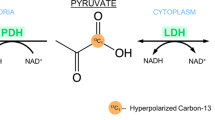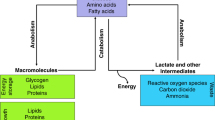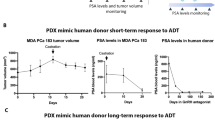Abstract
Most malignancies have increased glycolysis for energy requirement of rapid cell proliferation, which is the basis for tumor imaging through glucose analog FDG (2-deoxy-2-fluoro-D-glucose) with positron emission tomography. One of significant characteristics of prostate cancer is slow glycolysis and low FDG avidity. Recent studies showed that prostate cancer is associated with changes of fatty acid metabolism. Several enzymes involved in the metabolism of fatty acids have been determined to be altered in prostate cancer relative to normal prostate, which is indicative of an enhanced β-oxidation pathway in prostate cancer. Increased fatty acid utilization in prostate cancer provides both ATP and acetyl-coenzyme A (CoA); subsequently, increased availability of acetyl-CoA makes acceleration of citrate oxidation possible, which is an important energy source as well. Dominant fatty acid metabolism rather than glycolysis has the potential to be the basis for imaging diagnosis and targeted treatment of prostate cancer.
This is a preview of subscription content, access via your institution
Access options
Subscribe to this journal
Receive 4 print issues and online access
$259.00 per year
only $64.75 per issue
Buy this article
- Purchase on Springer Link
- Instant access to full article PDF
Prices may be subject to local taxes which are calculated during checkout

Similar content being viewed by others
References
Warburg O . Respiratory impairment in cancer cells. Science 1956; 124: 269–270.
Burger C, Wick M, Brusselback S, Muller R . Differential induction of metabolic genes after mitogen stimulation and during normal cell cycle progression. J Cell Sci 1994; 107: 241–252.
Waki A, Kato H, Yano R . The importance of glucose transport activity as the rate-limiting step of 2-deoxyglucose uptake in tumor cells in vitro. Nucl Med Biol 1998; 25: 593–597.
Avril N, Menzel M, Dose J . GLUT1 expression in tissue and F18-FDG uptake. J Nucl Med 2004; 45: 930–932.
Chung JH, Cho KJ, Lee SS, Baek HJ, Park JH, Cheon GJ et al. Overexpression of GLUT1 in lymphoid follicles correlates with false-positive F18-FDG results in lung cancer staging. J Nucl Med 2004; 45: 999–1003.
Medina RA, Owen GI . Glucose transporters: expression, regulation and cancer. Biol Res 2002; 35: 9–26.
Smith TA . Facilitative glucose transporter expression in human cancer tissue. Br J Biomed Sci 1999; 56: 285–292.
Effert PJ, Bares R, Handt S, Wolff JM, Bull U, Jakse G et al. Metabolic imaging of untreated prostate cancer by positron emission tomography with 18F-FDG. J Urol 1996; 155: 994–998.
Hofer C, Laubenbacker C, Block T, Braul J, Hartung R, Schwaiger M . FDG-PET is useless for the detection of local recurrence after radical prostatectomy. Eur Urol 1999; 36: 31–35.
Candler JD, Williams ED, Slavin JL, Best JD, Rogers S . Expression and localization of GLUT1 and GLUT12 in prostate carcinoma. Cancer 2003; 97: 2035–2042.
Singh G, Lakkis CL, Laucirica R, Epner DE . Regulation of prostate cell division by glucose. J Cell Physiol 1999; 180: 431–438.
Legaspi A, Jeevanandam M, Starnes HF . Whole body lipid and energy metabolism in the cancer patient. Metabolism 1987; 36: 958–963.
Hyltander A . Elevated energy expenditure in cancer patients with solid tumours. Eur J Cancer 1991; 27: 9–15.
Russell ST, Tisdale MJ . Effect of a tumor-derived lipid-mobilising factor on glucose and lipid metabolism in vivo. Br. J Cancer 2002; 87: 580–584.
Faergeman NJ, Knudsen J . Role of long-chain fatty acyl-CoA esters in the regulation of metabolism and in cell signaling. Biochem J 1997; 323: 1–12.
Tang DG, La E, Kern J, Kehrer JP . Fatty acid oxidation and signaling in apoptosis. Biol Chem 2002; 383: 425–442.
Baron A, Migita T, Tang D, Loda M . Fatty acid synthase: a metabolic oncogene in prostate cancer? J Cell Biochem 2004; 91: 47–53.
Epstein JI, Carmichael M, Partin AW . Fatty acid synthase as an independent predictor of pathologic state in adenocarcinoma of the prostate. Urology 1995; 45: 81–86.
Rossi S, Graner E, Febbo P, Weinstein L, Bhattacharya N, Onody T et al. Fatty acid synthase expression defines distinct molecular signatures in prostate cancer. Mol Cancer Res 2003; 1: 707–715.
Pizer ES, Chrest FJ, DiGiuseppe JA, Han WF . Pharmacological inhibitors of mammalian fatty acid synthase suppress DNA replication and induce apoptosis in tumor cell lines. Cancer Res 1998; 58: 4611–4615.
Li JN, Gorospe M, Chrest FJ, Kumaravel TS . Pharmacological inhibition of fatty acid synthase activity produces both cytostatic and cytotoxic effects modulated by p53. Cancer Res 2001; 61: 1493–1499.
De Schrijver E, Brusselmans K, Heyns W, Verhoeven G, Swinnen JV . RNA interference-mediated silencing of the fatty acid synthase gene attenuates growth and induces morphological changes and apoptosis of LNCaP prostate cancer cells. Cancer Res 2003; 63: 3799–3804.
Moore S, Knudsen B, True LD, Hawley S, Etzioni R, Wade C et al. Loss of stearoyl-CoA desaturase expression is a frequent event in prostate carcinoma. Int J cancer 2005; 114: 563–571.
Ntambi JM, Miyazaki M, Stoehr JP . Loss of stearoyl-CoA desaturase-1 function protects mice against adiposity. Proc Natl Acad Sci USA 2002; 99: 11482–11486.
Swinnen JV, Roskams T, Joniau S, Van Poppel H, Oyen R, Baert L et al. Overexpression of fatty acid synthase is an early and common event in the development of prostate cancer. Int J Cancer 2002; 98: 19–22.
Wanders RJ, Vreken P, den Boer ME, Wilburg FA . Disorders of mitochondrial fatty acyl-CoA beta-oxidation. J Inherit Metab Dis 1999; 22: 442–487.
Seedorf U, Brysch P, Engel T, Schrage K, Assmann G . Sterol carrier protein X is peroxisomal 3-oxoacyl coenzyme A thiolase with intrinsic sterol carrier and lipid transfer activity. J Biol Chem 1994; 269: 21277–21283.
Zha S, Ferdinandusse S, Hicks JL, Isaacs WB . Peroxisomal branched chain fatty acid beta-oxidation pathway is upregulated in prostate cancer. Prostate 2005; 63: 316–323.
Jiang Z, Woda BA, Rock KL, Xu Y, Savas L, Khan A et al. A new molecular marker for the detection of prostate carcinoma. Am J Surg Pathol 2001; 25: 1397–1404.
Luo J, Zha S, Gage WR . Alpha-methylacyl-CoA racemase: a new molecular marker for prostate cancer. Cancer Res 2002; 62: 2220–2226.
Rubin MA, Zhou M, Dhanasekaran SM, Varambally S, Bareette TR, Sanda MG et al. Alpha-methylacyl-coenzyme A racemase as a tissue biomarker for prostate cancer. JAMA 2002; 287: 1662–1670.
Kumar-Sinha C, Shah RB, Laxman B, Harwood J, Schmitz W, Conzelmann E et al. Elevated alpha-methylacyl-CoA racemase enzymatic activity in prostate cancer. Am J Pathol 2004; 164: 787–793.
Costello LC, Franklin RB, Narayan P . Citrate in the diagnosis of prostate cancer. Prostate 1999; 38: 237–245.
Costello LC, Franklin RB . Citrate metabolism of normal and malignant prostate epithelial cells. Urology 1997; 50: 3–12.
Costello LC, Feng P, Tan M, Franklin RB . Role of zinc in the pathogenesis and treatment of prostate cancer: critical issue to resolve. Prostate Cancer Prostate Dis 2004; 7: 11–117.
Kurhanewicz J, Vigneron DB, Hricak H, Narayan P, Carrol P, Nelson SJ et al. Three dimensional hydrogen-1 MR spectroscopic imaging of the in situ human prostate with high spatial resolution. Radiology 1996; 198: 795–805.
Cooper JE, Farid I . The role of citric acid in the physiology of the prostate: lactic/citrate in benign and malignant prostatic homogenates as an index of prostate malignancy. J Urol 1964; 92: 533–536.
Costello LC, Liu Y, Franklin RB . Zinc inhibition of mitochondrial aconitase and its importance in citrate metabolism of prostate epithelial cells. J Biol Chem 1997; 272: 28875–28881.
Costello LC, Franklin RB . The intermediary metabolism of the prostate: a key to understanding the pathogenesis and progression of prostate malignancy. Oncology 2000; 59: 269–282.
Fleshner N, Bagnell PS, Klotz L, Venkateswaran V . Dietary fat and prostate cancer. J Urol 2004; 171: S19–S24.
Pour PM, Croot K, Kazakoff K, Anderson K, Schally AV . Effects of high-fat diet on the patterns of prostatic cancer induced in rats by N-nitrosobis (2-oxopropyl) amine and testosterone. Cancer Res 1991; 51: 4757.
Wang Y, Corr JG, Thaler HT, Tao Y, Fair WR, Heston WD . Decreased growth of established human prostate LNCaP tumors in nude mice fed a low-fat diet. J Natl Cancer Inst 1995; 87: 1261–1456.
Hill P, Wynder EL, Garbaczewski L . Diet and urinary steroids in black and white North American men and black South African men. Cancer Res 1979; 39: 5101–5108.
Dorgan JF, Judd JT, Longcope C, Brown C, Schatzkin A, Clevidence BA et al. Effects of dietary fat and fiber on plasma and urine androgens and estrogens in men: a controlled feeding study. Am J Clin Nutr 1996; 64: 850–857.
Sonn GA, Aronson W, Litwin MS . Impact of Diet on prostate cancer: a review. Prostate Cancer Prostatic Dis 2005; 8: 304–310.
Ngo TH . Insulin-like growth factor I (IGF-I) and IGF binding protein-1 modulate prostate cancer cell growth and apoptosis: possible mediators for the effect of diet and exercise on cancer cell survival. Endocrinology 2003; 144: 2319–2324.
Prentice RL, Sheppard L . Dietary fat and cancer: consistency of the epidemiologic data, and disease prevention that may follow from a practical reduction in fat consumption. Cancer Causes Control 1990; 1: 81–88.
Chen YC, Chiang CI, Lin RS, Pu YS, Lai MK, Sung FC et al. Diet, vegetarian food and prostate carcinoma among men in Taiwan. Br J Cancer 2005; 93: 1057–1061.
Oyama N, Miller TR, Dehdashti F . C11-acetate PET imaging of prostate cancer: detection of recurrent disease at PSA relapse. J Nucl Med 2003; 44: 549–555.
Dimitrakopoulou-Strauss A, Strauss L . PET imaging of prostate cancer with C11-acetate. J Nucl Med 2003; 44: 556–558.
Author information
Authors and Affiliations
Corresponding author
Rights and permissions
About this article
Cite this article
Liu, Y. Fatty acid oxidation is a dominant bioenergetic pathway in prostate cancer. Prostate Cancer Prostatic Dis 9, 230–234 (2006). https://doi.org/10.1038/sj.pcan.4500879
Received:
Revised:
Accepted:
Published:
Issue Date:
DOI: https://doi.org/10.1038/sj.pcan.4500879
Keywords
This article is cited by
-
The GAPDH redox switch safeguards reductive capacity and enables survival of stressed tumour cells
Nature Metabolism (2023)
-
Sevoflurane but not propofol enhances ovarian cancer cell biology through regulating cellular metabolic and signaling mechanisms
Cell Biology and Toxicology (2023)
-
Molecular and metabolic alterations of 2,3-dihydroquinazolin-4(1H)-one derivatives in prostate cancer cell lines
Scientific Reports (2022)
-
Fatty acid oxidation enzyme Δ3, Δ2-enoyl-CoA isomerase 1 (ECI1) drives aggressive tumor phenotype and predicts poor clinical outcome in prostate cancer patients
Oncogene (2022)
-
Identification of lipidomic profiles associated with drug-resistant prostate cancer cells
Lipids in Health and Disease (2021)



